Say the words “bike lanes” and you might picture a muscle-bound person hunched over in a racing posture on a top-quality Cannondale, clad in skin-tight spandex as they tear down the street.
But a longer look at the cycling networks of British Columbia will reveal a much more diverse spectrum of users. Seniors. Families. Commuters. And, in some cases not visibly, disabled people.
There is very little data that exists on bike lane ridership in B.C. While automated counters have been in place for years, the portrait they paint of who uses cycling infrastructure is, at best, incomplete.
I spoke with disabled people across B.C. who use cycling infrastructure in a variety of ways. They told me about their experiences and thoughts on what can be done to improve accessibility.
Here is what I learned.
Not just about bike infrastructure
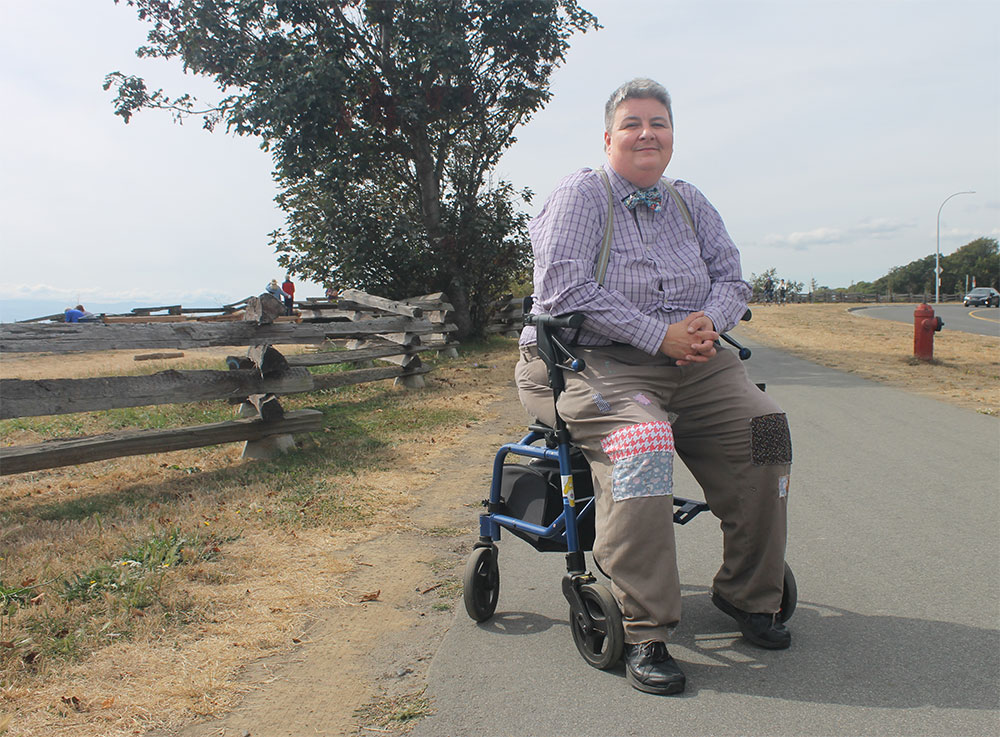
JJ Jones, who lives in Victoria’s Fairfield neighbourhood, lives with epidermolysis bullosa, a condition that causes fragile and blistering skin. Taking to a bicycle to get around the city has sometimes been more comfortable than walking.
“In the past, I've actually used my bicycle to get around when I'm having a flare up,” Jones explained. "Walking around can be a bit tough when your feet are covered with blisters.”
But last year, Jones also sustained a lower back injury stemming from a motor vehicle accident. Months afterward, determined to keep active and to help with their recovery, they adapted to a walker.
“The bus service is really bad in Fairfield so I couldn't rely on that, either,” Jones said. “So that's why I was really determined to get back my ability to walk.”
They say that in some places in Victoria, the sidewalks are too narrow for people with walkers to easily pass each other. For this reason, multi-use pathways designed for both cyclists and pedestrians are more accessible for Jones — they’re wider and there is more room to move.
The experience has left Jones feeling more aware of the challenges faced by people who use assisted walking devices.
“I just feel like if I had been in a different neighbourhood, would I have made the kind of recovery I have already made, which is pretty significant?” they said.
“It's not just about the bike infrastructure, though I think the bike infrastructure is really critical. But I think it's about making the community accessible and making space for people. Space for people that are not in cars, because I don't drive. I don't have a license. And even if I did, I don't have the money to buy a car.”
One thing they also highlight is a lack of signage.
One paved path on the southeast side of Beacon Hill Park transitions abruptly from smooth asphalt to a bumpy chip trail, with no warning.
Jones says that kind of terrain would force most people with mobility issues to simply turn back.
“What I've noticed while having this device is that we don't signpost that,” Jones said. “Wayfinding is as important as the infrastructure itself.”
Jones says that involving disabled people in infrastructure design can make a difference. Jones says collaboration has been lacking, and infrastructure debates have been dominated by what they call a disingenuous discourse.
“I'm just really tired of seeing folks use disability either way, disingenuously, whether it's people who don't want to lose parking for themselves who are arguing it's really about people with disabilities, while at the same time not demanding for that parking to be set aside for people with disabilities, or whether it's people who want bike lanes who aren't willing to believe that there can be impacts on people with disabilities.”
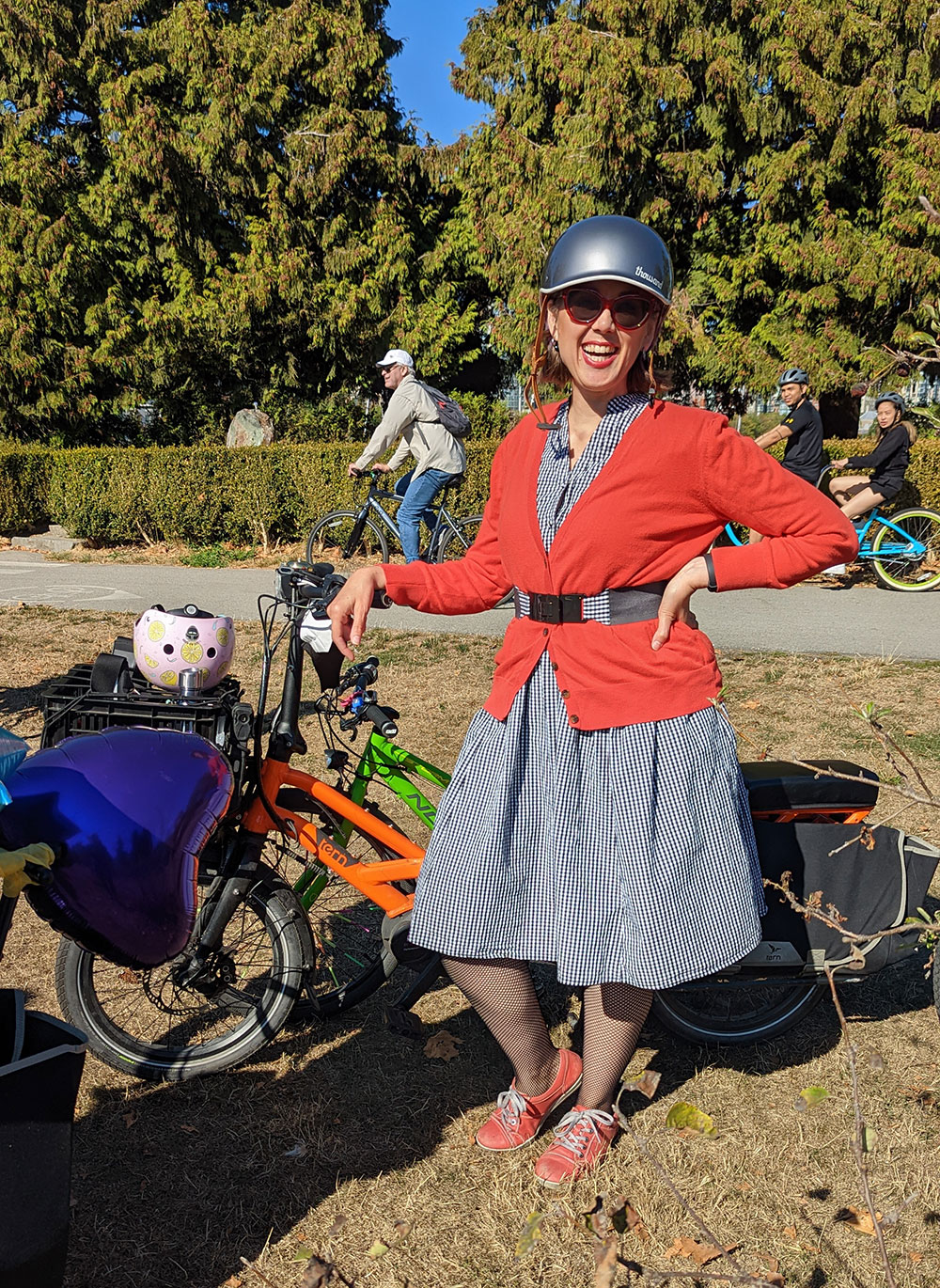
Improving access for cyclists who can’t walk
For Lisa Corriveau, a longtime cyclist in Vancouver, biking has been a default for years due to a long-term disability.
Corriveau was diagnosed with osteoarthritis in her hip just before her 40th birthday, but had been experiencing pain since her mid-20s. It was only after the diagnosis that she found cycling as a default method of transportation, carrying a cane on her bicycle for when she did need to walk.
A step-through frame also helped with her condition. Her hip pain made it hard to swing her leg over the back of a bike, and standing on one leg for that motion was also difficult.
In December, with pain coming back even during biking, Corriveau went in for hip surgery. Her recovery afterwards has relied heavily on Vancouver’s cycling network.
“When I was just starting to bike after my surgery, I was pretty tentative, and I didn't want to go too fast and I didn't want to have to stop suddenly,” Corriveau said.
“I didn't want to be in busy traffic. So having quiet neighbourhood bikeways or protected lanes is more comfortable for me.”
Another big benefit to sticking to Vancouver’s cycling network that Corriveau discovered was that the smooth pavement also helped her condition. Bumpy roads and gravel paths would lead to a painful ride. One area that she sees a need for improvement, though, is in the parking department.
“Having bike racks that have enough space for me to navigate around them,” Corriveau said. “That's one thing I struggled with a lot when I was having more trouble walking, is just being able to lock up my bike. It was awkward to bend over and access, because they were really packed in with other bikes.”
Another area where she also sees a need for change is in our assumptions about the ability of all cyclists. In particular, Corriveau says that dismount signs, such as ones that are found around Vancouver’s seawall, are unfair for disabled cyclists who aren’t able to walk.
Offset gates can also force dismounts, according to Corriveau, and that limits access for riders who are paraplegic, using adaptive trikes or other methods. She counts herself among those riders for whom dismounting is not a reasonable ask.
“They've started just putting up signs that say bike slowly rather than dismount, but sometimes you still see ‘Must get off your bike and walk,’” Corriveau said. “I used to refuse to do that, because it was painful to walk my bike.”
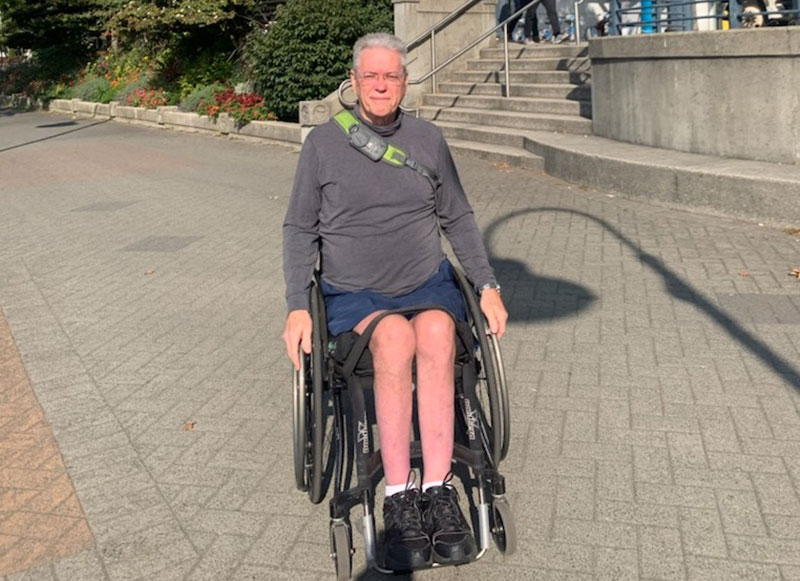
One such user who cannot walk is 69-year-old Jacques Courteau of Vancouver, a former unit director of the RCMP.
During a heat wave on the East Coast in 2007, where he was working at the time, he passed out while riding his motorcycle. The resulting crash put him into a coma, leaving him paraplegic with a paralyzed tongue. Waking up 11 days later, Courteau was quick to accept his situation and determined to stay active.
“I was a very active guy,” he said. “I was a former motorcycle racer, a soccer player. All kinds of sports. And so that did not stop me. Basically, I just kept on going, but in a wheelchair.”
Following the accident, he requested a transfer from his employer to the West Coast, avoiding the snowier climate of Ottawa. While Courteau no longer had to contend with snowdrifts, he nevertheless had to adapt to Vancouver’s steeper terrain.
Courteau uses a power attachment that turns his wheelchair into a motorized trike, lifting the two front caster wheels off the ground so it can ride on the front wheels, where the motor is. “The [power attachment] I have is home-built,” Courteau said.
“Mine can go 40 kilometres an hour, which is absolutely ridiculous. There's no way I can go that fast. The chair doesn't have any suspension on it. But what I do then is I can use all the bicycle paths to get around town.”
He uses the bicycle paths instead of the sidewalks not just because of the speed of his device, but because the sidewalks in Vancouver are in horrible shape. The bicycle paths are still new, and Courteau says they are “smooth as marble.”
“I've had zero problems using the bicycle paths. I think that because I respect the same rules that [cyclists] do, I've been accepted in those paths without any problems for the past 10 years now.” However, he’s quick to observe that manual wheelchairs would struggle with hillier sections, and if the city wants to be accessible to all, it should also be fixing up its sidewalks.
“It will be interesting, in 10 or 15 years' time, when the cycle lanes start to be dishevelled the same way that the streets are, how many people are going to still use the bicycle lanes?” Courteau said.
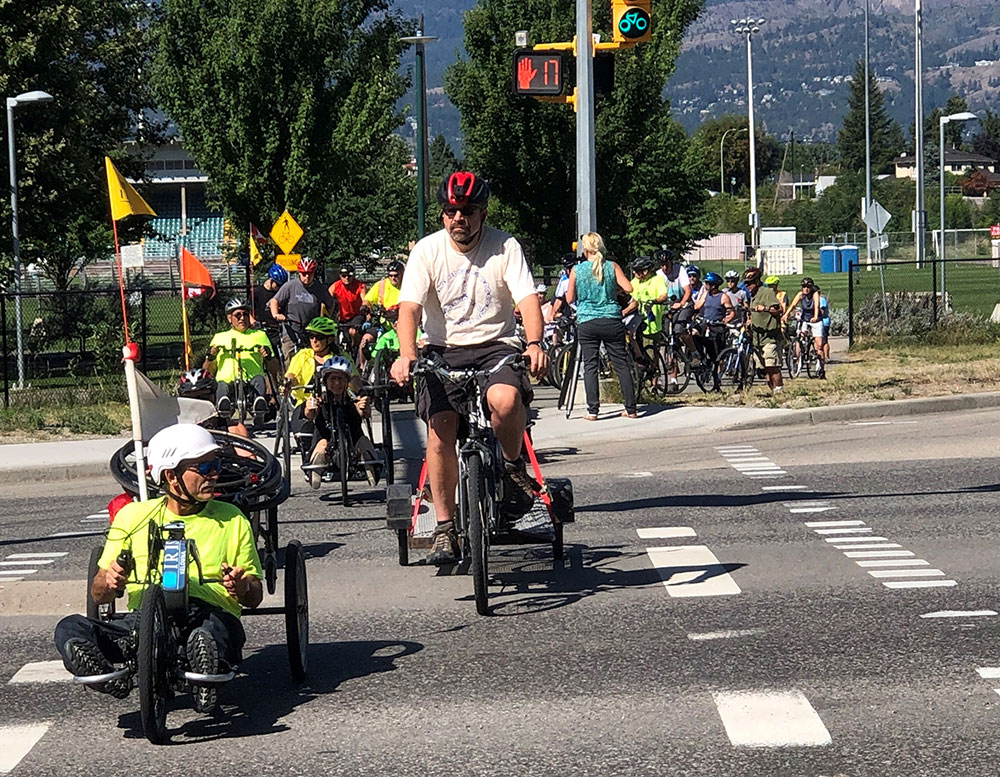
One wheelchair user who was taking to the streets well before most bike lanes in B.C. had been built is Paul Clark.
Clark now lives in Kelowna. He grew up in Woodstock, Ontario, and was injured in a motorcycle accident in 1973, at the age of 15. In his final high school years and in the beginnings of his university life, Clark became frustrated with getting around via taxis, and started wheeling himself around.
That morphed into an engineering spirit, finding ways to go faster and modifying his wheelchairs, and culminated in an athletic career that saw Clark attending the Paralympic Games in 1980, 1984 and 1988. In those days, Clark would train on highways with logging trucks whizzing by him.
Transitioning to a handcycle in the early 2000s, Clark says in recent years he’s become more cautious and found the benefits in protected cycling infrastructure.
“If there's a bike lane to choose or a route where I can go on a bike lane, I will certainly choose it,” Clark said. “There is no way I'll go on the road if I don't have to.”
The problem, he says, is that much of it is still unfinished. While Clark praises the work that has been done in Kelowna, including the Abbott Active Transportation Corridor and the Okanagan Rail Trail, he finds that encountering incomplete areas can be chaotic when people are trying to find their way around.
Another issue that Clark points out is the height of signal light buttons, which he says he can only reach from his wheelchair or handcycle with a stick. That demonstrates a bigger problem with consultation, which Clark says he’s seen from a lifetime of using a wheelchair.
He also sees systemic problems in how drivers are not adapting to the shift in mode use. Clark says that many people in cars have told him he is too low to the ground to see. As he points out, his wheelchair doesn’t place him lower to the ground than a child, and if drivers are not seeing him, they’ll also be at risk of not seeing kids.
“What I'd like to highlight is that drivers don't watch for cyclists in particular,” Clark says. “And now that cyclists have motors on their bikes, they're going faster. So it's much more important for the drivers to be watching for those cyclists, not just me.”
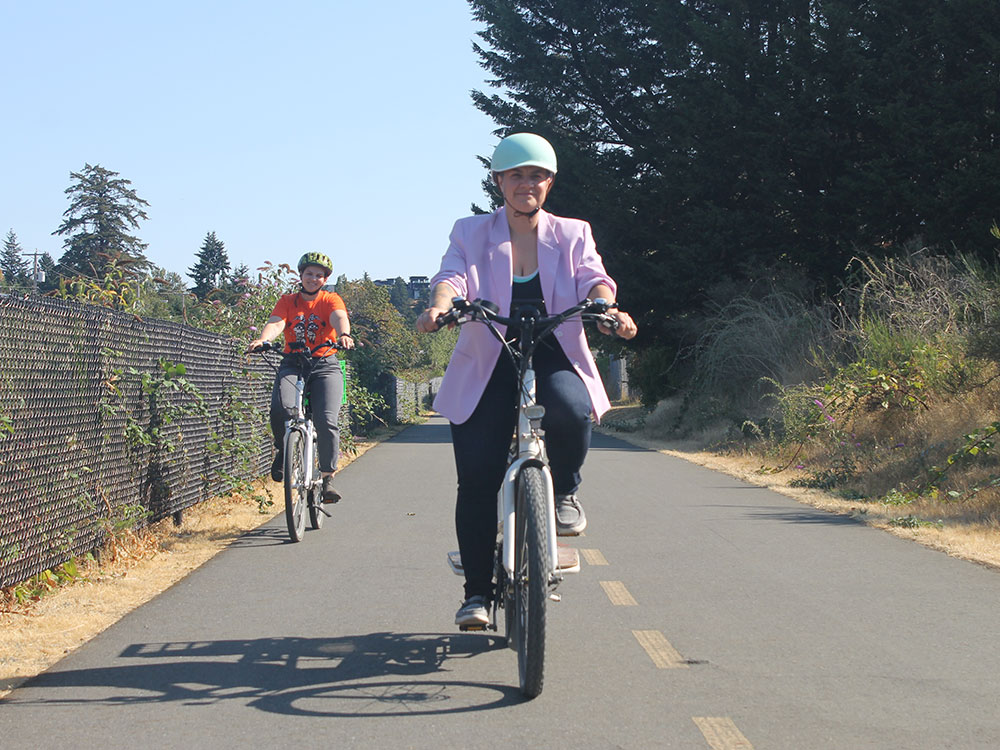
Teaming up for a more accessible commute
Two cyclists who look out for each other are Kris Westendorp and Naomi Wilde, friends and co-workers who “bikepool” to their workplace in Victoria on a regular basis.
Westendorp and Wilde both have Ehlers-Danlos syndrome, a genetic condition that damages connective tissue, leading to overly flexible joints and fragile skin. In addition, they both have ADHD, which keeps Westendorp from driving. Wilde also has respiratory illness and heart disease that have made public transportation risky in the time of COVID-19.
Wilde is also hard of hearing and uses hearing aids, which are not a good option for them during physical activity due to potential moisture damage to the devices. Wilde says replacing their hearing aids would be a cost in the thousands of dollars.
Because of that, Westendorp and Wilde teamed up to make their commute more accessible.
“I won't necessarily hear a bike bell,” Wilde says.
“Bike bells are a very high-pitched range, which the majority of people with hearing loss — it's in the high-pitched range. Kris literally will alert me when somebody passing us has rung the bell.”
Westendorp says wide, multi-use pathways like the Galloping Goose Trail have been helpful for their commute. There’s more room to move, they say, which means the stakes are lower if Wilde doesn’t hear a bike bell.
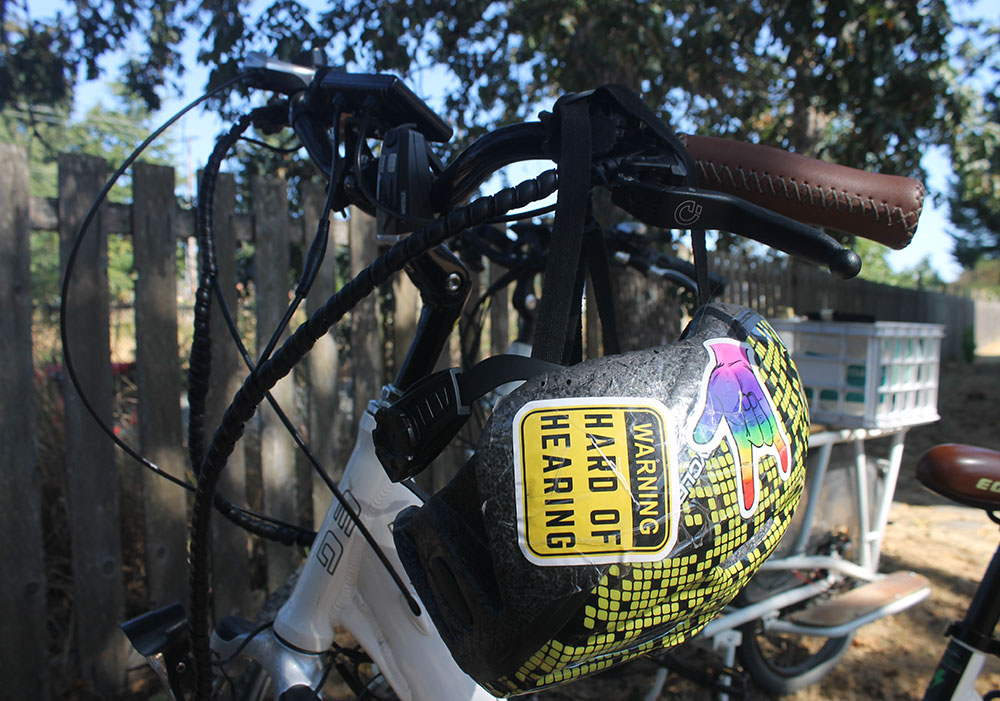
“The trickiest part is in the downtown, the two-way bike paths, which seemed like a great idea and in some ways work, but in other ways is a little bit stressful because people will try to pass and they're going into oncoming bike traffic,” Westendorp noted.
“A multimodal city makes room for everyone, and I never want to have safe biking at the exclusion of someone else being safe,” they add. "I believe that everyone can be safe and that's really what my ideal city looks like.”
Wilde adds that more people biking means fewer cars on the road and more parking at their destination.
At the same time, they also want people to recognize that individuals with disabilities can and do cycle.
“I think that it's really important if people can embrace the concept of trying to either make less assumptions, or generate more alternative stories for themselves,” Wilde said.
“The negative interactions that I've had on the bike lanes have been about people a) assuming the worst, but b) it literally never occurs to them that someone could have a disability and be riding a bike.”
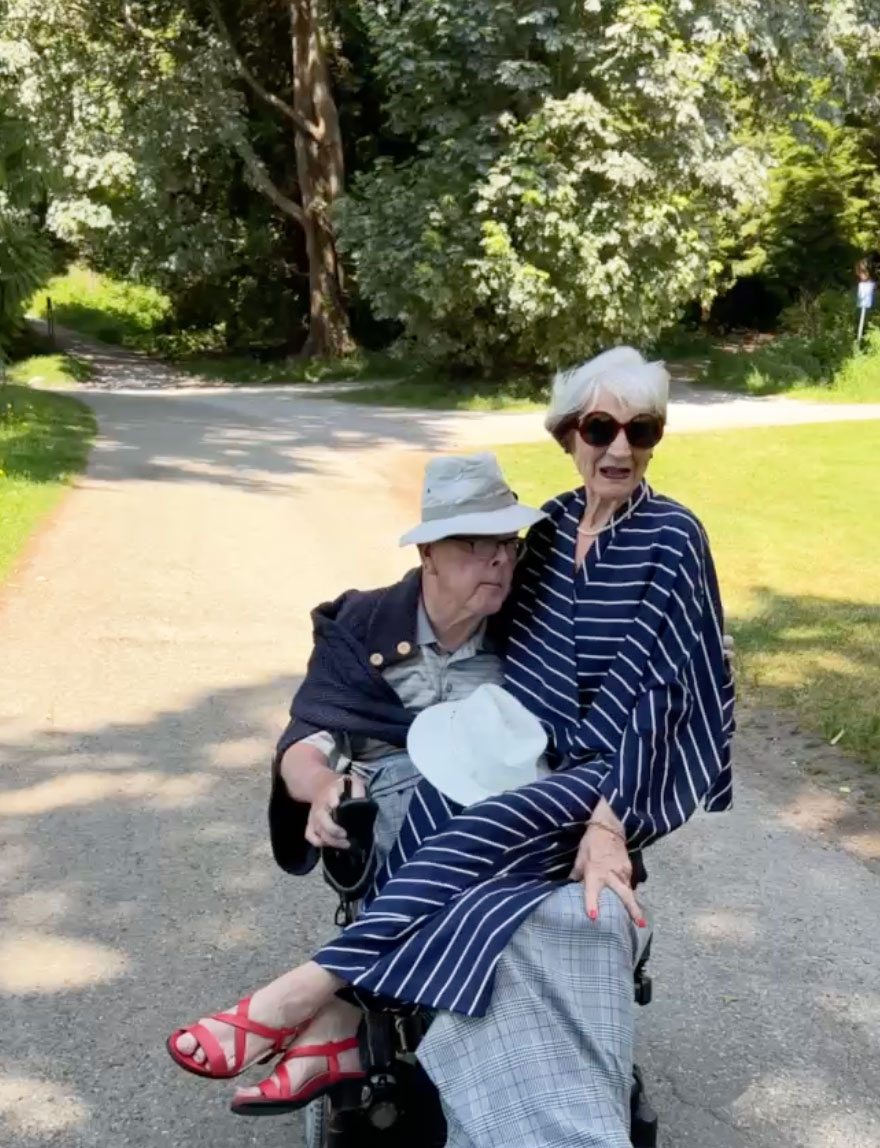
Two people who found their lives transformed by an unforeseen disability are married couple Peter and Janice Foran, who divide their time between Vancouver and Victoria.
The pair have been together for 44 years. About 25 years ago, Peter was diagnosed with multiple sclerosis, which has him using a powered wheelchair.
The couple has found unexpected ways in which the world around them has failed to accommodate disabled people, such as in the design of their condominium building.
“We pretty much fought for a door opener here,” Janice said. “There's a little garden area with three steps up. So instead of making it a runway or anything, they went around the side and it curves up to this grass… but all of these things needed to be looked after. To be asked for.”
The couple first took to the bike lanes on a night out in downtown Victoria. Coming down Pandora Street, Janice told Peter she was feeling tired and asked if she could hop on to the chair for a ride. At first they felt self-conscious going into the bike lanes to zip home, but quickly took to the idea and now frequently hit the road with Janice riding half on the armrest, and half in Peter’s lap.
“It's kind of a joy because people feel that they can make comments as you go by,” said Janice.
“We get everything in the book, like ‘you've got another ride for me,’ or ‘can I jump on too?’ Others go: ‘Oh, that looks so wonderful.’”
The mode shift is here to say
While they now live in Victoria, Peter and Janice also recently spent six months in Vancouver. In comparing the two cities, Peter says that he finds Victoria’s bike lanes are fantastic, but Vancouver’s are “like interstate highways.”
“We've used the bike lanes in Vancouver to go to the hospital,” Peter said. “I've gone to my doctor's appointments. We go shopping. We've gone to the harbour. We've gone around Stanley Park with my kids, thinking ‘whoa, these guys have put mega bucks, mega planning, and they want to be world-class.'”
Like JJ Jones and Jacques Courteau, though, Peter Foran is concerned about what appears to be a lack of care invested in sidewalks. He and Janice are critical of disrepaired sidewalks in both Victoria and Vancouver, and sometimes poles and other obstacles make sidewalks difficult to navigate.
One particularly bad stretch in Victoria caused Peter to tip his wheelchair off the ledge, and he fell and fractured his hip. That incident made Peter a committed bike lane user.
“I'm a little nervous that I'm getting on the bike trails these days with these great big, fat-tired, heavy-duty electric bikes.” Peter said. “I think we're gonna have to go through a phase of 'maybe there should be some rules.'”
Nevertheless, he thinks that the transportation shift away from cars is here to stay.
Seeing families out on the multi-use paths in Victoria affirms this belief for Peter, and he has voiced those beliefs to the government.
“Some of the letters I've written to the mayor are kind of ‘bear with it. You'll be Joan of Arc for a year or two and they're going to want to burn you at the stake. You'll suffer for bringing in the bike lanes and suffer for things you're doing. But they will look back and say it was the right thing to do.’” ![]()
Read more: Health, Rights + Justice, Transportation, Urban Planning


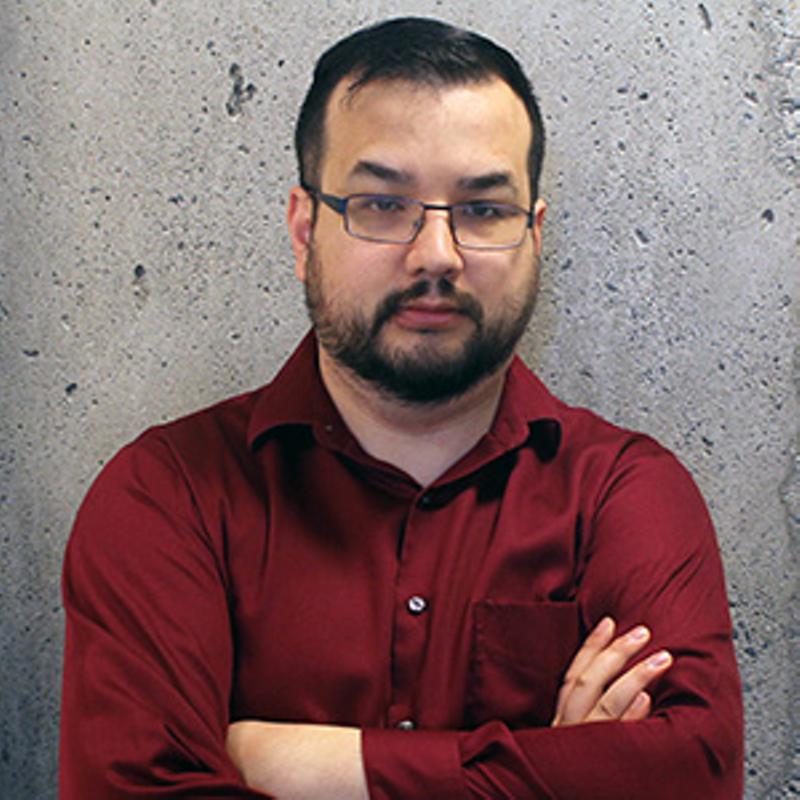

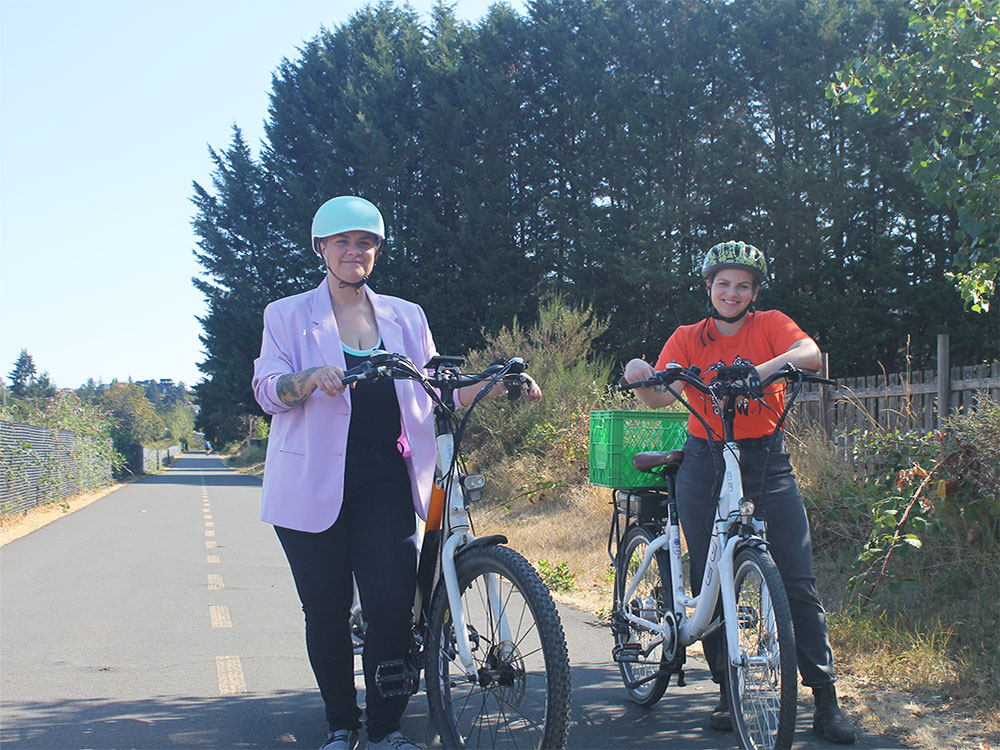








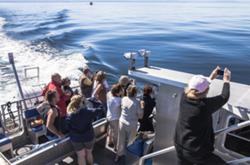

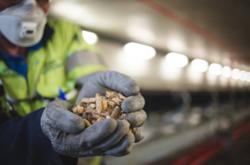
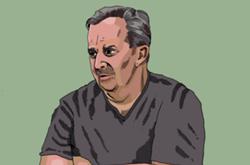
Tyee Commenting Guidelines
Comments that violate guidelines risk being deleted, and violations may result in a temporary or permanent user ban. Maintain the spirit of good conversation to stay in the discussion.
*Please note The Tyee is not a forum for spreading misinformation about COVID-19, denying its existence or minimizing its risk to public health.
Do:
Do not: